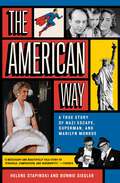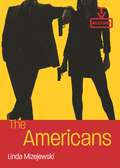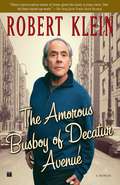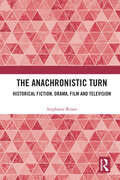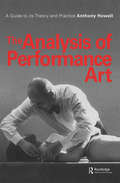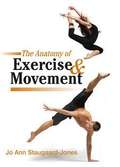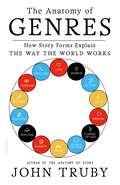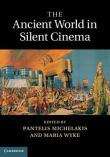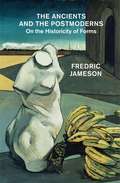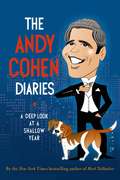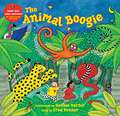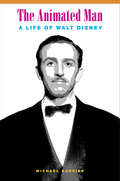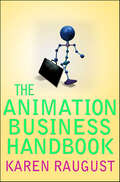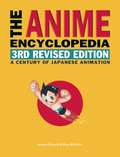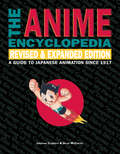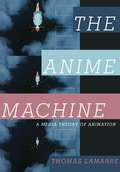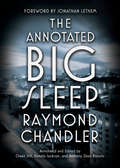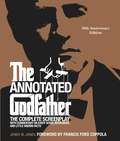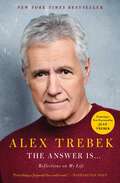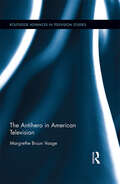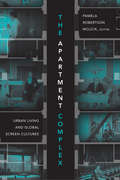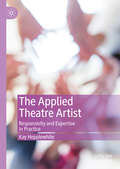- Table View
- List View
The American Way: A True Story of Nazi Escape, Superman, and Marilyn Monroe
by Helene Stapinski Bonnie SieglerIn this &“necessary and beautifully told story of struggle, compassion and serendipity&” (Forbes), the publisher of DC Comics comes to the rescue of a family trying to flee Nazi Berlin, their lives linking up with a dazzling cast of 20th-century icons, all eagerly pursuing the American Dream.Family lore had it that Bonnie Siegler&’s grandfather crossed paths in Midtown Manhattan late one night in 1954 with Marilyn Monroe, her white dress flying up around her as she filmed a scene for The Seven Year Itch. An amateur filmmaker, Jules Schulback had his home movie camera with him, capturing what would become the only surviving footage of that legendary night. Bonnie wasn&’t sure she quite believed her grandfather&’s story…until, cleaning out his apartment, she found the film reel. The discovery would prompt her to investigate all of her grandfather&’s seemingly tall tales—and lead her in pursuit of a remarkable piece of forgotten history that reads like fiction but is all true. A &“fast-moving American epic with a cast of refugees and starlets, publishers and bootleggers, comic-book creators and sports legends&” (The Washington Post), The American Way follows two very different men—Jules Schulback and his unlikely benefactor, DC Comics publisher (and sometimes pornographer) Harry Donenfeld—on an exuberant true-life adventure linking glamorous old Hollywood, the birth of the comic book, and one family&’s experiences during the Holocaust. It&’s an &“amazing&” story told &“with grace, verve, and compassion&” (The Jerusalem Post) of two strivers living through an extraordinary moment in American history, their lives intersecting with a glittering array of stars in a &“colorful&” and &“punchy&” (The New York Times Book Review) tale of hope and reinvention, of daring escapes and fake identities, of big dreams and the magic of movies, and what it means to be a real-life Superman.
The Americans (TV Milestones Series)
by Linda MizejewskiBased on the actual KGB strategy of planting "illegals" into American life during the Cold War, The Americans (FX 2013–2018) focuses on Philip and Elizabeth Jennings (Matthew Rhys and Kerri Russell), Soviet spies posing as middlebrow travel agents in the Virginia suburbs. Groundbreaking and unsettling, The Americans spins its stories of espionage, violence, and politics around narratives of marriage, romance, bromance, and family. Exploring the series’ bold merger of the spy genre and domestic melodrama, author Linda Mizejewski focuses on the characters and relationships that made this series memorable: the extraordinary women who defy the femme fatale stereotype of the spy genre, the conflicted men, and perhaps most shockingly, the children who are both victims and provocateurs Do viewers of this Cold War thriller root for "the good guys"—the American agents in pursuit of the Jennings—or for the Jennings themselves, the attractive couple whose personal stories compel us even as they plot the takedown of the United States? Mizejewski argues for the importance of The Americans’ portrayal of 1980s suburban life as a microcosm of the moral complexities of citizenship and national identity. Drawing on television studies and feminist media theory, this book examines the series’ seamless loop of espionage violence and family melodrama, as well as its savvy uses of 1980s pop culture and music. Far from invoking nostalgia, the replication of the 1980s "look" invokes uncertainties about how, exactly, we should see Reagan’s America and the Cold War. Yet the appeal of this series rests on solid footing in the Americanism it both critiques and espouses. Mizejewski examines The Americans’ struggles with this ambiguity and with the contradictions of identity, gender, marriage, and the meanings of home. Everyone from scholars and students of television and media studies, genre studies, gender and sexuality studies, and popular culture, to superfans who can’t believe the show is over will revel in this highly approachable and fun read.
The Amorous Busboy of Decatur Avenue: A Child of the Fifties Looks Back
by Robert KleinDear Reader,When we asked the beloved award-winning comedian and actor Robert Klein to write a book, you can imagine our utter surprise when he told us that he wanted to write about sixth-century Chinese pottery. Thankfully, he hit a creative brick wall (since he doesn't really know anything about pottery from China or anywhere else). Then came similar failures to write books about sea turtles, circumnavigation of the globe, building jet engines at home, the sociology of chickens, or fungi of the skin.Luckily, Mr. Klein's paramount concern was the consumer. He knew that if we, his publishers, were going to boldly ask you to purchase his book (see above for price), he would have to write something so good, so worthwhile, so meaningful as to make you want to send additional money to your bookseller in gratitude for having allowed you to partake in this reading experience.So Mr. Klein set out to write about what he knows best: himself. This book is about the adventures of a child who becomes a young man: how he thinks and dreams and lusts and fears and laughs and handles adversity. From the beginning of his distinguished career as a comedian, Robert Klein established himself as a pioneer in observational humor and razor-sharp routines that are infectiously funny. Now -- for the first time -- Klein brings his trademark humor and honesty to the printed page. In this portrait of a comic as a young man, Klein takes us back to the people and streets of his Bronx neighborhood, the eccentric cast of characters in the Catskills hotels and bungalow colonies where he worked, the college dorms where he received more than an academic education, the 1964 World's Fair where he fell in love, New York City and Chicago in the 1960s as he developed his talent, and Los Angeles just as he was about to embark on a show business career. Throughout, Klein reveals the hilarity of growing up and explores the mysteries and his own foibles in sex and relationships. He recounts with wit and poignancy losing his virginity with a prostitute, bringing home a German girlfriend to his Jewish family, and the amorous adventures of the busboy he once was.With an ego more fragile than Chinese pottery, Robert Klein has written a funny and evocative coming-of-age memoir -- well worth the price (if we say so ourselves). Enjoy.All the best,The Publisher
The Anachronistic Turn: Historical Fiction, Drama, Film and Television
by Stephanie RussoThe Anachronistic Turn: Historical Fiction, Drama, Film and Television is the first study to investigate the ways in which the creative use of anachronism in historical fictions can allow us to rethink the relationship between past and present. Through an examination of literary, cinematic, and popular texts and practices, this book investigates how twenty-first century historical fictions use creative anachronisms as a way of understanding modern issues and anxieties. Drawing together a wide range of texts across all forms of historical fiction - novels, dramas, musicals, films and television - this book re-frames anachronism not as an error, but as a deliberate strategy that emphasises the fictionalising tendencies of all forms of historical writing. The book achieves this by exploring three core themes: the developing trends in the twenty-first century for creators of historical fiction to include deliberate anachronisms, such as contemporary references, music, and language; the ways in which the deliberate use of anachronism in historical fiction can allow us to rethink the relationship between past and present, and; the way that contemporary historical fiction uses anachronism to better understand modern issues and anxieties. This book will appeal to students and scholars of historical fiction, contemporary historical film and television studies, and historical theatre studies.
The Analysis of Performance Art: A Guide to its Theory and Practice
by Anthony Howell A. HowellThis finely illustrated book offers a simple yet comprehensive 'grammar' of a new discipline. Performance Art first became popular in the fifties when artists began creating 'happenings'. Since then the artist as a performer has challenged many of the accepted rules of the theatre and radically altered our notion of what constitutes visual art. This is the first publication to outline the essential characteristics of the field and to put forward a method for teaching the subject as a discipline distinct from dance, drama, painting or sculpture.Taking the theory of primary and secondary colours as his model, Anthony Howell posits three primaries of action and shows how these may be mixed to obtain a secondary range of actions. Based on a taught course, the system is designed for practical use in the studio and is also entertaining to explore. Examples are cited from leading performance groups and practitioners such as Bobbie Baker, Orlan, Stelarc, Annie Sprinkle, Robert Wilson, Goat Island, and Station House Opera. This volume, however, is not just an illustrated grammar of action - it also shows how the syntax of that grammar has psychoanalytic repercussions. This enables the performer to relate the system to lived experience, ensuring a realisation that meaning is being dealt with through these actions and that the stystem set forth is more than a dry structuring of the characteristics of movement.Freud's notion of 'transference' and Lacan's understanding of 'repetition' are compared to a performer's usage of the same terms. Thus the book provides a psychoanalytic critique of performance at the same time as it outlines an efficient method for creating live work on both fine art and theatre courses.
The Anatomy of Exercise And Movement: For the Study of Dance, Pilates, Sport and Yoga
by Jo Staugaard-JonesThis book serves as a bridge between biomechanics and the practice of sport, Pilates, yoga, and dance, providing the reader with a complete understanding of how the body functions while exercising.
The Anatomy of Genres: How Story Forms Explain the Way the World Works
by John TrubyA guide to understanding the major genres of the story world by the legendary writing teacher and author of The Anatomy of Story, John Truby.Most people think genres are simply categories on Netflix or Amazon that provide a helpful guide to making entertainment choices. Most people are wrong. Genre stories aren’t just a small subset of the films, video games, TV shows, and books that people consume. They are the all-stars of the entertainment world, comprising the vast majority of popular stories worldwide. That’s why businesses—movie studios, production companies, video game studios, and publishing houses—buy and sell them. Writers who want to succeed professionally must write the stories these businesses want to buy. Simply put, the storytelling game is won by mastering the structure of genres.The Anatomy of Genres: How Story Forms Explain the Way the World Works is the legendary writing teacher John Truby’s step-by-step guide to understanding and using the basic building blocks of the story world. He details the three ironclad rules of successful genre writing, and analyzes more than a dozen major genres and the essential plot events, or “beats,” that define each of them. As he shows, the ability to combine these beats in the right way is what separates stories that sell from those that don’t. Truby also reveals how a single story can combine elements of different genres, and how the best writers use this technique to craft unforgettable stories that stand out from the crowd. Just as Truby’s first book, The Anatomy of Story, changed the way writers develop stories, The Anatomy of Genres will enhance their quality and expand the impact they have on the world.
The Ancient World in Silent Cinema
by Maria Wyke Pantelis MichelakisIn the first four decades of cinema, hundreds of films were made that drew their inspiration from ancient Greece, Rome, Egypt and the Bible. Few of these films have been studied, and even fewer have received critical attention. The films in question, ranging from historical and mythological epics to adaptations of ancient drama, burlesques, animated cartoons and documentaries, suggest a preoccupation with the ancient world that competes in intensity and breadth with that of Hollywood's classical era. What contribution did the worlds of antiquity make to early cinema, and how did they themselves change as a result? Existing prints as well as ephemera scattered in film archives and libraries around the world constitute an enormous field of research, and this edited collection is a first systematic attempt to focus on the instrumental role of silent cinema in early twentieth-century conceptualizations of the ancient Mediterranean and Middle East.
The Ancients and the Postmoderns
by Fredric JamesonFredric Jameson sweeps from the Renaissance to The Wire High modernism is now as far from us as antiquity was for the Renaissance. Such is the premise of Fredric Jameson's major new work in which modernist works, this time in painting (Rubens) and music (Wagner and Mahler), are pitted against late-modernist ones (in film) as well as a variety of postmodern experiments (from SF to The Wire, from "Eurotrash" in opera to Altman and East German literature): all of which attempt, in their different ways, to invent new forms to grasp a specific social totality. Throughout the historical periods, argues Jameson, the question of narrative persists through its multiple formal changes and metamorphoses.From the Hardcover edition.
The Andy Cohen Diaries: A Deep Look at a Shallow Year
by Andy CohenA year in the whirlwind life of the beloved pop icon Andy Cohen, in his own cheeky, candid, and irreverent words<P> As a TV Producer and host of the smash late night show Watch What Happens Live, Andy Cohen has a front row seat to an exciting world not many get to see. In this dishy, detailed diary of one year in his life, Andy goes out on the town, drops names, hosts a ton of shows, becomes codependent with Real Housewives, makes trouble, calls his mom, drops some more names, and, while searching for love, finds it with a dog. We learn everything from which celebrity peed in her WWHL dressing room to which Housewives are causing trouble and how. Nothing is off limits – including dating. We see Andy at home and with close friends and family (including his beloved and unforgettable mom). Throughout, Andy tells us not only what goes down, but exactly what he thinks about it. Inspired by the diaries of another celebrity-obsessed Andy (Warhol), this honest, irreverent, and laugh-out-loud funny book is a one-of-a-kind account of the whos and whats of pop culture in the 21st century.
The Animal Boogie
by Debbie HarterCan you boogie? Down in the Indian jungle, the children and animals are learning about actions like leaping, stomping, shaking and flapping while meeting different jungle creatures.
The Animated Man: A Life of Walt Disney
by Michael BarrierWalt Disney (1901-1966) was one of the most significant creative forces of the twentieth century, a man who made a lasting impact on the art of the animated film, the history of American business, and the evolution of twentieth-century American culture. He was both a creative visionary and a dynamic entrepreneur, roles whose demands he often could not reconcile. In his compelling new biography, noted animation historian Michael Barrier avoids the well-traveled paths of previous biographers, who have tended to portray a blemish-free Disney or to indulge in lurid speculation. Instead, he takes the full measure of the man in his many aspects. A consummate storyteller, Barrier describes how Disney transformed himself from Midwestern farm boy to scrambling young businessman to pioneering artist and, finally, to entrepreneur on a grand scale. Barrier describes in absorbing detail how Disney synchronized sound with animation in Steamboat Willie; created in Snow White and the Seven Dwarfs sympathetic cartoon characters whose appeal rivaled that of the best live-action performers; grasped television's true potential as an unparalleled promotional device; and--not least--parlayed a backyard railroad into the Disneyland juggernaut. Based on decades of painstaking research in the Disney studio's archives and dozens of public and private archives in the United States and Europe, The Animated Man offers freshly documented and illuminating accounts of Disney's childhood and young adulthood in rural Missouri and Kansas City. It sheds new light on such crucial episodes in Disney's life as the devastating 1941 strike at his studio, when his ambitions as artist and entrepreneur first came into serious conflict. Beginning in 1969, two and a half years after Disney's death, Barrier recorded long interviews with more than 150 people who worked alongside Disney, some as early as 1922. Now almost all deceased, only a few were ever interviewed for other books. Barrier juxtaposes Disney's own recollections against the memories of those other players to great effect. What emerges is a portrait of Walt Disney as a flawed but fascinating artist, one whose imaginative leaps allowed him to vault ahead of the competition and produce work that even today commands the attention of audiences worldwide.
The Animation Business Handbook
by Karen RaugustToday, animation is more prevalent than ever in television, films, video games, and the Internet. Karen Raugust has created a much needed, comprehensive look at the entire business. She shows in detail how a successful animation studio or entrepreneur operates, describes the process of developing an animation property from the concept stage through the finished product, and outlines business methods used to create and sell animated media.Topics covered include:* Distribution, sales, and marketing methods* Financing, budgeting, costs and revenue opportunities* The creation of ancillary entertainment and merchandise* Animation in international markets.The Animation Business Handbook is the quintessential reference for anyone in or considering entering the animation industry.
The Animation Smears Book: Uncovering Film's Most Elusive Technique
by Christian AvenderThroughout cinema, there have been various techniques to depict motion, and one style in particular is the fascinating use of smears in animation. Incredibly popular and captivating to artists, these animation smears are frames that creatively replicate motion blur captured on film, which is the phenomena that we commonly observe in our everyday life.The vast world of different techniques for smears is explored in this book, expanding way beyond their commonly believed starting point in the 1940s to their actual origins that date back to the beginning of art history with illustrations and prototypes that led to their usage in some of the earliest known theatrical animations.The Animation Smears Book: Uncovering Film’s Most Elusive Technique is a comprehensive guide that provides extensive information on the stylistic and creative aspects of smears and their impact, on how they make use of the way we perceive motion. Additionally, this book also reveals the names of artists who helped develop smears and the original techniques that were used.Thoroughly examined by a professional animator, the animation smear is highlighted as a versatile technique used in all forms of animation including 3D and stop‑motion. This book answers all of the questions that readers ever had about smears and brings clarity to this simple yet mysterious trick that has puzzled fans, scholars, and historians for centuries.
The Anime Ecology: A Genealogy of Television, Animation, and Game Media
by Thomas LamarreA major work destined to change how scholars and students look at television and animation With the release of author Thomas Lamarre&’s field-defining study The Anime Machine, critics established Lamarre as a leading voice in the field of Japanese animation. He now returns with The Anime Ecology, broadening his insights to give a complete account of anime&’s relationship to television while placing it within important historical and global frameworks. Lamarre takes advantage of the overlaps between television, anime, and new media—from console games and video to iOS games and streaming—to show how animation helps us think through television in the contemporary moment. He offers remarkable close readings of individual anime while demonstrating how infrastructures and platforms have transformed anime into emergent media (such as social media and transmedia) and launched it worldwide. Thoughtful, thorough illustrations plus exhaustive research and an impressive scope make The Anime Ecology at once an essential reference book, a valuable resource for scholars, and a foundational textbook for students.
The Anime Encyclopedia, 3rd Revised Edition
by Jonathan Clements Helen Mccarthy"Impressive, exhaustive, labyrinthine, and obsessive--The Anime Encyclopedia is an astonishing piece of work."--Neil GaimanOver one thousand new entries . . . over four thousand updates . . . over one million words. . .This third edition of the landmark reference work has six additional years of information on Japanese animation, its practitioners and products, plus incisive thematic entries on anime history and culture. With credits, links, cross-references, and content advisories for parents and libraries.Watch for the e-book edition in December 2014, ISBN 9781611729092, $24.95Jonathan Clements has been an editor of Manga Max and a contributing editor of Newtype USA.Helen McCarthy was founding editor of Anime UK and editor of Manga Mania.
The Anime Encyclopedia, Revised & Expanded Edition
by Jonathan Clements Helen MccarthyBigger and better! Our first edition rocked the anime world with its in-depth entries on anime famous and obscure and its superb index/film finder. Now this fantastic book is 40 percent larger--with all-new entries on hundreds of anime released after 2001, updates on older entries, and over fifty thousand words on anime creators (like Tezuka and Otomo) and genres ("Early Anime," "Science Fiction and Robots," etc.). An absolute must-have for every anime shelf!"If I only had space on my overcrowded shelf for one book on anime, this would be it. If I had no space on my shelf I'd select two books at random and drop them into the bin, just to make room-- it's that indispensable."-- Paul Jacques, Anime on DVD"While you may not agree with their opinons on a given anime, they are informative and entertaining, especially when skewering a really bad anime." -- Frames Per Second
The Anime Machine: A Media Theory of Animation
by Thomas LamarreDespite the longevity of animation and its significance within the history of cinema, film theorists have focused on live-action motion pictures and largely ignored hand-drawn and computer-generated movies. Thomas Lamarre contends that the history, techniques, and complex visual language of animation, particularly Japanese animation, demands serious and sustained engagement, and in The Anime Machine he lays the foundation for a new critical theory for reading Japanese animation, showing how anime fundamentally differs from other visual media.The Anime Machine defines the visual characteristics of anime and the meanings generated by those specifically &“animetic&” effects—the multiplanar image, the distributive field of vision, exploded projection, modulation, and other techniques of character animation—through close analysis of major films and television series, studios, animators, and directors, as well as Japanese theories of animation. Lamarre first addresses the technology of anime: the cells on which the images are drawn, the animation stand at which the animator works, the layers of drawings in a frame, the techniques of drawing and blurring lines, how characters are made to move. He then examines foundational works of anime, including the films and television series of Miyazaki Hayao and Anno Hideaki, the multimedia art of Murakami Takashi, and CLAMP&’s manga and anime adaptations, to illuminate the profound connections between animators, characters, spectators, and technology.Working at the intersection of the philosophy of technology and the history of thought, Lamarre explores how anime and its related media entail material orientations and demonstrates concretely how the &“animetic machine&” encourages a specific approach to thinking about technology and opens new ways for understanding our place in the technologized world around us.
The Annotated Big Sleep
by Raymond ChandlerThe first fully annotated edition of Raymond Chandler&’s 1939 classic The Big Sleep features hundreds of illuminating notes and images alongside the full text of the novel and is an essential addition to any crime fiction fan&’s library. A masterpiece of noir, Raymond Chandler's The Big Sleep helped to define a genre. Today it remains one of the most celebrated and stylish novels of the twentieth century. This comprehensive, annotated edition offers a fascinating look behind the scenes of the novel, bringing the gritty and seductive world of Chandler's iconic private eye Philip Marlowe to life. The Annotated Big Sleep solidifies the novel&’s position as one of the great works of American fiction and will surprise and enthrall Chandler&’s biggest fans. Including: -Personal letters and source texts -The historical context of Chandler&’s Los Angeles, including maps and images -Film stills and art from the early pulps -An analysis of class, gender, sexuality, and ethnicity in the novel
The Annotated Godfather: 50th Anniversary Edition with the Complete Screenplay, Commentary on Every Scene, Interviews, and Little-Known Facts
by Jenny M. JonesCelebrating the 50th anniversary of The Godfather, this authorized, annotated and illustrated edition of the complete, unedited screenplay includes all the little-known facts, behind-the-scenes intrigue, and first-person reflections from cast and crew members on the making of this landmark film.From its ingenious cinematic innovations and memorable, oft-quoted script to its iconic cast, including Marlon Brando, Al Pacino, Robert Duvall, James Caan, The Godfather is considered by many to be the greatest movie ever made. And yet, the history of its making is so colorful, so chaotic, that one cannot help but marvel at the seemingly insurmountable odds it overcame to become a true cinematic masterpiece, and a film that continues to captivate its audience decades after its release.In this authorized, annotated, and illustrated edition of the complete screenplay, nearly every scene is examined and dissected, including: Fascinating commentary on technical details about the filming and shooting locationsTales from the set, including arguments, accidents, anecdotes and practical jokesProfiles of the actors and stories of how they were castDeleted scenes that never made the final cut, and the goofs and gaffes that didAnd much more!Interviews with former Paramount executives, cast and crew members, and director Francis Ford Coppola, round out the commentary and shed new light on everything you thought you knew about this most influential film. With more than 200 photographs, this a truly unique, collectable keepsake for every Godfather fan.
The Answer Is . . .: Reflections on My Life
by Alex TrebekLongtime Jeopardy! host and television icon Alex Trebek reflects on his life and career.When he debuted as the host of Jeopardy! in 1984, Alex Trebek became something like a family member to millions of television viewers, bringing entertainment and education into their homes five nights a week. In 2019, he made the stunning announcement that he had been diagnosed with Stage IV pancreatic cancer. What followed was an incredible outpouring of love and kindness. Social media was flooded with messages of support, and the Jeopardy! studio received boxes of cards and letters offering guidance, encouragement, and prayers. For more than three decades, Trebek had resisted countless appeals to write a book about his life. Yet he was moved so much by all the goodwill, he felt compelled to finally share his story. &“I want people to know a little more about the person they have been cheering on for the past year,&” he writes. The book combines illuminating personal anecdotes with Trebek&’s thoughts on a range of topics, including marriage, parenthood, education, success, spirituality, and philanthropy. Trebek also addresses the questions asked most often by Jeopardy! fans, such as what prompted him to shave his signature mustache, his insights on legendary players like Ken Jennings and James Holzhauer, and his opinion of Will Ferrell&’s Saturday Night Live impersonation. The book uses a novel structure inspired by Jeopardy! and features dozens of never-before-seen photos that candidly capture Trebek over the years. This wise, charming, and inspiring book is further evidence of why Trebek has long been considered one of the most beloved and respected figures in entertainment.
The Antihero in American Television (Routledge Advances in Television Studies)
by Margrethe Bruun VaageThe antihero prevails in recent American drama television series. Characters such as mobster kingpin Tony Soprano (The Sopranos), meth cook and gangster-in-the-making Walter White (Breaking Bad) and serial killer Dexter Morgan (Dexter) are not morally good, so how do these television series make us engage in these morally bad main characters? And what does this tell us about our moral psychological make-up, and more specifically, about the moral psychology of fiction? Vaage argues that the fictional status of these series deactivates rational, deliberate moral evaluation, making the spectator rely on moral emotions and intuitions that are relatively easy to manipulate with narrative strategies. Nevertheless, she also argues that these series regularly encourage reactivation of deliberate, moral evaluation. In so doing, these fictional series can teach us something about ourselves as moral beings—what our moral intuitions and emotions are, and how these might differ from deliberate, moral evaluation.
The Apartment Complex: Urban Living and Global Screen Cultures
by Pamela Robertson WojcikFrom the bachelor pad that Jack Lemmon's C. C. Baxter loans out to his superiors in Billy Wilder's The Apartment (1960) to the crumbling tenement in a dystopian Taipei in Tsai Ming-liang's The Hole (1998), the apartment in films and television series is often more than just a setting: it can motivate or shape the narrative in key ways. Such works belong to a critical genre identified by Pamela Robertson Wojcik as the apartment plot, which comprises specific thematic, visual, and narrative conventions that explore modern urbanism's various forms and possibilities. In The Apartment Complex a diverse group of international scholars discuss the apartment plot in a global context, examining films made both within and beyond the Hollywood studios. The contributors consider the apartment plot's intersections with film noir, horror, comedy, and the musical, addressing how different national or historical contexts modify the apartment plot and how the genre's framework allows us to rethink the work of auteurs and identify productive connections and tensions between otherwise disparate texts. Contributors. Steven Cohan, Michael DeAngelis, Veronica Fitzpatrick, Annamarie Jagose, Paula J. Massood, Joe McElhaney, Merrill Schleier, Lee Wallace, Pamela Robertson Wojcik
The Apartment Plot: Urban Living in American Film and Popular Culture, 1945 to 1975
by Pamela Robertson WojcikRethinking the significance of films including Pillow Talk, Rear Window, and The Seven Year Itch, Pamela Robertson Wojcik examines the popularity of the "apartment plot," her term for stories in which the apartment functions as a central narrative device. From the baby boom years into the 1970s, the apartment plot was not only key to films; it also surfaced in TV shows, Broadway plays, literature, and comic strips, from The Honeymooners and The Mary Tyler Moore Show to Subways are for Sleeping and Apartment 3-G. By identifying the apartment plot as a film genre, Wojcik reveals affinities between movies generally viewed as belonging to such distinct genres as film noir, romantic comedy, and melodrama. She analyzes the apartment plot as part of a mid-twentieth-century urban discourse, showing how it offers a vision of home centered on values of community, visibility, contact, mobility, impermanence, and porousness that contrasts with views of home as private, stable, and family-based. Wojcik suggests that the apartment plot presents a philosophy of urbanism related to the theories of Jane Jacobs and Henri Lefebvre. Urban apartments were important spaces for negotiating gender, sexuality, race, and class in mid-twentieth-century America.
The Applied Theatre Artist: Responsivity and Expertise in Practice
by Kay HepplewhiteThis book analyses the work of applied theatre practitioners using a new framework of ‘responsivity’ to make visible their unique expertise. In-depth investigation of practice combines with theorisation to provide a fresh view of the work of artists and facilitators. Case studies are drawn from community contexts: with women, mental health service users, refugees, adults with a learning disability, older people in care, and young people in school. Common skills and qualities are given a vocabulary to help define applied theatre work, such as awareness, anticipation, adaptation, attunement, and responsiveness. The Applied Theatre Artist is of scholarly, practical, and educational interest. The book offers detailed analysis of how skilled theatre artists make in-action decisions within socially engaged participatory projects. Rich description of in-session activity reveals what workshop facilitators actually do and how they think, offering a rare focus in applied theatre.
